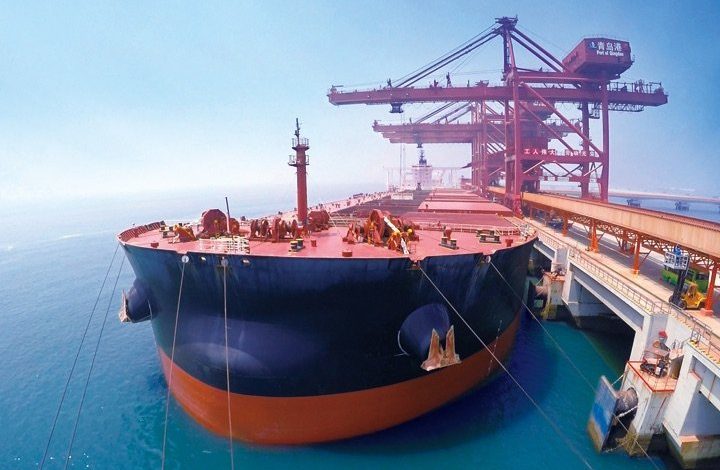Dry bulk pins hopes on China’s economy staging a comeback in H2

China released official Q2 GDP figures today showing how damaging ongoing lockdowns have been to shipping’s most important economy.
Output contracted by 2.6% between April and June compared with the previous quarter, the statistics bureau said, the poorest performance since the Wuhan lockdown at the start of the pandemic.
Lockdowns are persisting into Q3. Thirty-one Chinese cities are under full or partial lockdowns, affecting 247.5m people in regions accounting for about 17.5% of the country’s economic activity, according to an analysis released this week by Japanese investment bank Nomura.
Iron ore exports to China fell by 3.2% in the first half
Analysts remain divided on whether the economy has now bottomed out.
Julian Evans-Pritchard, China economist at Capital Economics, in a note on Friday, said growth was “likely to remain relatively weak over the coming quarters”.
“We expect the official GDP figures to eke out growth of 3%-4% this year but think the reality on the ground will be closer to zero growth across the year as a whole,” he suggested.
The data comes in the wake of mounting challenges in China’s key real estate sector – which by some estimates accounts for a quarter of gross domestic product – with weak home sales in recent months.
A growing number of homebuyers are also refusing to pay their mortgages over worries their homes will not be built on time.
Buyers in more than 100 unfinished housing complexes across the country have taken to social media to warn that they will stop making monthly mortgage payments until developers complete the projects.
Up to RMB1.5trn ($220bn) of mortgage loans are linked to unfinished residential projects, according to ANZ.
Nomura estimates that developers have only delivered around 60% of homes they pre-sold between 2013 and 2020, while in those years China’s outstanding mortgage loans rose by RMB26.3trn.
“The presale model has significantly increased developers’ leverage, so a disorderly deleveraging may not only lead to a credit crunch for developers and massive defaults in offshore dollar bond markets, but also rising nonperforming loans for banks, which sit at the center of China’s financial system,” Ting Lu, chief China economist at Nomura, said in a research note.
For dry bulk, the sluggish Chinese economy and troubled real estate sector saw iron ore exports to the world’s most populous nation fall in the first half by 3.2%.
Given the lower requirements for iron ore, not only have exports to China declined, but there has also been a build-up of inventories in steel mills and ports. This is likely to delay the recovery in iron ore exports to China.
“With China accounting for 71% of total iron ore trade, and iron ore accounting for 74% of cargo handled by capesizes, this slowdown has greatly affected the segment,” commented Niels Rasmussen, chief shipping analyst at BIMCO.
In the first half of the year, China’s seaborne bulk commodity imports declined by 8.3% year-on-year to 941.7m tonnes, with June amounting to just 146.4m tonnes, the lowest level since February 2020, according to data from Braemar.
“While Q2 will largely reflect the impact of the lockdowns, we are still confident activity will improve in 2H 2022, replicated by a rise in the country’s dry bulk commodity demand,” Braemar predicted.
Capesize vessels have brighter prospects in the second half, according to a new report from Arrow Group, as coal and iron ore demand should remain propped up by the energy crisis and China reopening.
In a move to jumpstart the economy, the Chinese government has accelerated the issue of special purpose bonds, issuing the majority of its 2022 quota of RMB3.6trn in the first six months of the year.
“In addition, China’s Ministry of Finance is considering issuing an additional RMB1.5trn out of their 2023 quota in the second half of the year in order to boost growth,” said BIMCO’s Rasmussen “As most of these bonds are allocated to infrastructure projects, if the government approves this additional stimulus, the Chinese steel sector should recover in the second half of the year.”
Also suggesting a better H2 is on the cards are analysts at Dutch bank ING, who argued in a research note published today that the recovery of the economy has begun.
“As we believe the economy has bottomed out, we are revising upward China’s GDP growth rate for 2022 to 4.4% from 3.6% previously. It is still slower than the government target of 5.5% for this year,” ING stated, pointing to June’s recovery in retail sales up 3.1%year-on-year from -6.7% year-on-year in May, with car sales increasing by 13.9% year-on-year in June from -5.9% year-on-year in May, mainly because of subsidies for the consumption of new energy cars. Industrial production rose 3.9% year-on-year in June from 0.7% in May.
